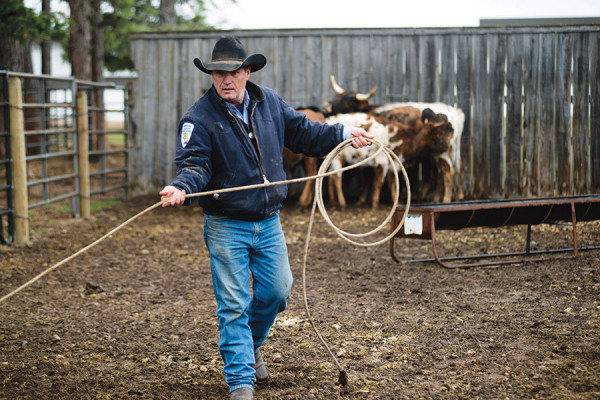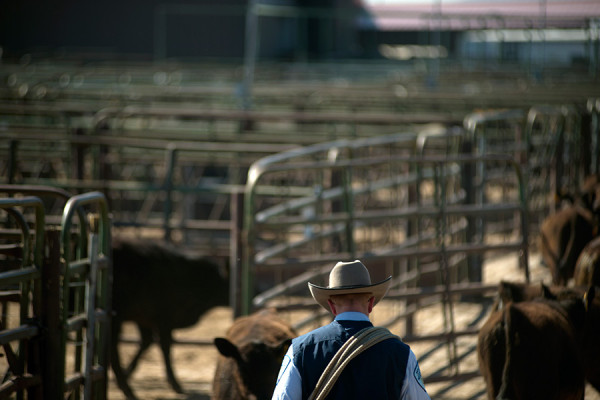Editor’s Note: This is one of the stories featured in the summer edition of Flathead Living magazine. Pick up a free copy on newsstands throughout the valley.
The lawman tilts his cowboy hat to block the descending sun and steers his horse into a pasture where a herd of cattle grazes. He studies each cow’s brand, looking for anything out of place, which could be a sign of cattle rustling, or maybe just a stray cow or innocent branding mishap. It’s his job to enforce the sacred livestock laws of the American West.
On the open range, he carries a firearm for protection and rope for rounding up animals. After spotting a suspicious brand, he looks around. Cattle rustlers don’t take kindly to law enforcement. Then he reaches into the pocket of his jeans and does what any good frontier detective would do: he pulls out his iPhone.
Brand inspection? There’s an app for that.
Humans have branded livestock to mark ownership for thousands of years, with paintings found in tombs depicting ancient Egyptians branding oxen. Europeans brought the practice over to the United States, where it became an indispensable tool for cattlemen in the free-range, 19th century West, including Montana.
The state Department of Livestock and Montana Historical Society have catalogued brands on microfilm dating back to 1873, an undertaking made possible by a donation from author Ivan Doig and his wife. It was Doig’s way of memorializing brands, which he calls the “classical language of the American West.”
In Montana, some brands have been in continuous use for well over a century, while new ones are constantly registered with the state. They may be deeply personal, made up of letters and symbols of great importance to the owner, or they may be strictly professional, created simply to distinguish ownership without sentiment.
But they all tell stories: of family, of origins, of relationships between people and animals. And those stories carry great meaning in a state where agriculture has remained the largest industry through decades of profound societal and ecological change, which means the protectors of those stories are fundamentally vital to both Montana’s economy and its cultural heritage. We call those protectors brand inspectors, and we rely on them to preserve the integrity of our classical language.

With modern innovations such as apps that access state brand databases, inspectors’ jobs may look different today but their core duties remain largely unchanged from 1885, when Montana’s territorial government appointed seven inspector-detectives to combat rustling, the term used for livestock theft. The Department of Livestock says those detectives represented the first law enforcement agency in Montana, which didn’t achieve statehood until 1889.
Leading up to the Montana Territory’s famous “Cowboy Legislature” of 1885, which provided the legal structure and authority for appointing the first brand inspectors, widespread rustling had prompted ranchers to take justice into their own hands. A cattleman named Granville Stuart, president of the newly established Montana Stockgrowers Association, directed a vigilante operation in 1884 to hunt down rustlers.
“Stuart’s Stranglers,” as the vigilantes would become known, killed at least 30 men and perhaps as many as 60, with the vehement support of a rancher on the North Dakota border named Theodore Roosevelt. Teddy would go on to become president of the United States, while Stuart would also go into politics, heading up the Montana Board of Stock Commissioners that laid the groundwork for formal brand enforcement at the 1885 Legislature.
As members of one of Montana’s oldest law enforcement brethrens, today’s stock investigators take deep pride in their jobs, which are as quintessential to the mystique of the American West as they are essential to a healthy livestock industry. While there are hundreds of regular brand inspectors across the state, only 21 are licensed investigators in the vein of those original seven: gun-toting lawmen who wield the greatest power in the fight against livestock crimes.
Investigators perform many of the same tasks as other inspectors – checking brands, logging information about livestock and its owners with the state – but they have also received their certifications from the Montana Law Enforcement Academy. If they or other inspectors suspect a crime, including modern-day cattle and horse rustling, it’s their responsibility to initiate an investigation and use their law enforcement authority to solve the case. That includes C.S.I.-like forensic work, interrogations and arrests.
They drive big pickups with sirens and the title painted on the side, “Stock Inspector and Investigator,” distinguishing them from other inspectors. They’re the type of tough-as-nails, cowboy hat-wearing lawmen we see in Western movies, except they have iPhones in their pockets.
“We have as much arrest authority as any county sheriff or highway patrolman,” says Tom Harmon, district investigator for Flathead, Lincoln and Lake counties, and a portion of Sanders County.
Harmon has been in the brand inspection business for 40 years. Like other investigators, he started out as a regular inspector. He spent years as the market inspector for the Kalispell livestock auction, which closed in 2003 following years of decline. He says more than 50,000 cattle moved through the Kalispell auction in a single year in the 1970s. By the time it shut down, that number had dwindled to fewer than 3,000. The closest auction is now in Missoula, one of 13 statewide.
Ernie McCaffree, the Department of Livestock’s supervisor for western Montana and also a certified investigator, has been in the brand business for 35 years, often working alongside Harmon. They both live in the Kalispell area. Like Harmon, McCaffree speaks of the changes in Northwest Montana’s livestock industry with both lament and marvel. While cattle have sharply decreased, McCaffree says horses have increased, though not a lot of them are used for traditional agricultural purposes.
“They’re recreational horses,” says McCaffree, whose job as supervisor covers both major branches of the livestock department: brand enforcement and veterinary animal health.
Whether people own stock for English-style equestrian riding or ranch work or meat, it’s their choice whether to brand their animals. Montana law doesn’t require it, but McCaffree says it’s typically in their best interest to do so. The reasons include both the nefarious and the more commonplace: an animal might be stolen, though that’s not as widespread today, or it might simply wander off, ending up as a lone stray or getting mixed up in a different herd. Either way, owners have a lot better chance of getting their animals back if they’re marked.
“You’re doing it for your own protection,” McCaffree says.
If livestock owners choose to brand their animals, they must register the brands with the Department of Livestock. Under state law, stock in Montana must undergo inspections when transported across county and state lines, and during change of ownership. Whenever an animal goes to auction for sale, inspectors look for a brand and make sure everything is in order. If there’s no brand, they could be looking at a stolen animal and have no way of knowing.
In addition to state-employed inspectors, there are also 509 local, or county, inspectors. These are typically ranchers or other residents with knowledge of livestock who receive fees per inspection. Livestock owners might call them if a state inspector isn’t available or for any number of other reasons. County inspectors keep their fees, while salaried state inspectors give them to the state.

The agriculture department maintains a database of registered brands, which can be accessed online or through the app. And every 10 years, the department updates its “Brand Bible,” a hefty book containing all of the state’s recorded brands. Other agricultural states and Canadian provinces have their own books.
Annually, inspectors from across the Western U.S. and Canada gather at an International Livestock Identification Association conference, which changes locations from year to year, in what amounts to a Woodstock for brand geeks. They come armed with Brand Bibles, ready to compare and contrast the newest North American brand fashions.
The next update for Montana’s Brand Bible is 2021. New brands will be added and inactive ones will either be sold or go idle. Inevitably, a number of owners will have moved away or died, rendering the brand inactive. There are currently more than 50,000 brands recorded in Montana.
Brands contain up to three characters, consisting of any combination of letters, numbers and symbols, so long as they don’t duplicate an existing recorded brand. Some look like straightforward initials, while others seem as if they’re from an algebra equation or secret language. Inspectors use a common lingo so they can understand each other: an “H” that has a “D” coming off its right bottom is “H hangs a D.” Symbols can include anything from hearts and diamonds to stick figure human legs.
Traditionally, livestock owners have used a red-hot iron rod with their brand’s pattern on the end. The iron is pressed against the animal’s hide, leaving behind a dark mark. Though hot irons are still widely used, more people are employing freeze branding, in which either dry ice and alcohol or liquid nitrogen cools the iron rod to an extremely low temperature. The hair grows back white, particularly helpful for dark-haired stock.
Both methods require an iron that has been specifically shaped to the brand’s orderly arrangement of characters. McCaffree is part of a small fraternity of branding iron-makers in Montana. At his Kalispell home, he hammers and welds pieces of iron together to create the custom-made tools.
Cows are branded on the ribs, shoulder or hip. Horses are branded on the shoulder, hip, neck or jaw, but not the ribs. It’s up to the owner to do a good job.
“It’s only as good as it’s put on,” Harmon says. “The brand is their return address back if they go missing.”
Cattle and horse rustling is no longer a hanging offense, but it’s a felony crime punishable by a lengthy jail sentence and large fine. Nor is it as prevalent as in those troubled days of the 1880s, especially in Montana, McCaffree says. He attributes much of that to the state’s strong inspection system.
Some states have dropped horse inspection requirements, while others just have less stringent laws than Montana’s. For one, Montana is unusual in requiring inspections when animals are transported across county lines. States generally only require inspections for leaving the state or at the point of sale. That means livestock in Montana is under much more frequent surveillance.
“I wouldn’t want to try stealing anything in this state,” McCaffree says. “There’s too many eyes and ears out there.”
But crime does occur. In 2011, the Montana Department of Livestock in conjunction with the Nevada Department of Agriculture recovered 34 cows and 25 yearlings and calves that had been stolen in Montana. The 59 animals were found in the high desert near the Nevada-California border.
Also in 2011, Reuters published a story with the headline, “Western States Report Comeback in Cattle Rustling.” The story described rustlers using four-wheelers and GPS technology across the West, in part responding to the poor economy. In Montana alone, investigators had recovered more than 7,300 stolen or missing cattle worth nearly $8 million in the previous three years, and those figures were thought to represent only a fraction of the real totals.
“What you see as far as figures from livestock departments is a drop in the bucket from what’s been going on,” Kim Baker, president of the Montana Cattlemen’s Association, said in the article.
McCaffree and Harmon have both recovered stolen horses, including one horse returned to its owner after 12 years missing. They’ve also encountered senseless killing. Harmon recalls when somebody shot five cows dead, seemingly just for the hell of it. Harmon tracked him down and arrested him. The shooter was charged with felony criminal mischief and forced to pay restitution, which at the time was around $800-900 per head but now would be more than $2,000 each.
Investigators act on tips, calls from stock owners and their own observations and inclinations. They conduct horseback patrols to “look for anything out of place,” Harmon says.

“It keeps guys honest,” McCaffree says of the patrols.
If they see something that requires further examination, they have to rope the suspect animal while on horseback, jump off the horse and tie it to a fence or tree or anything that can secure the animal while they examine it. This requires supreme horsemanship and roping skills, which means it’s necessary for investigators to have ranching or perhaps rodeo backgrounds.
Dim brands or other innocent mistakes usually end up being the reasons for drawing investigators’ attention, but more sinister deeds may also be at play. Sometimes it requires a meeting with the owner, who isn’t always excited to see a detective at his front door.
“But they usually come around after you talk to them for awhile,” Harmon says with the authority of somebody who knows how to make people “come around.”
As with any profession, many aspects of investigators’ jobs are mundane, others fairly strange. McCaffree tells the story of an animal hoarder. When he showed up with Harmon and several other investigators at the man’s property, they found a home as littered with junk inside as animals outside. They rounded up 100 pigs, which were “running wild” and living in unsuitable conditions, to transport to the auction in Billings.
While they were there, the owner offered them stale doughnuts. They declined, so he gave them to the pigs. It turns out the man had been feeding his pigs, cattle and horses exclusively stale bread products that grocery stores were throwing out. Investigators later took away the man’s horses and cattle as well.
“The horses and pigs actually did OK with bread and doughnuts,” McCaffree says. “But the cattle need roughage for cud. They weren’t doing too good.”
With 75 years of brand inspection experience between them, McCaffree and Harmon are a lot closer to the end of their careers than the beginning. In an era where auctions close down due to lack of livestock and younger generations have a closer relationship to their smartphone than the land, it’s fair to wonder what the future holds for the profession. When the old-timers like Harmon and McCaffree retire, will there be equally skilled replacements waiting in the wings?
The answer, as it has been for more than a century, appears to be yes. Look no further than Keith Bond, district investigator for the Missoula area. Bond is the son of another investigator, Tyler Bond, who patrols Powder River and Carter counties in the state’s distant southeastern corner.
Half the age of many of his counterparts, Bond represents a new generation of brand inspectors eager to take up the torch. If anything, the young guys probably know their way around an iPhone better than the old-timers. And in today’s world, that goes a long way no matter what language you speak, even if it’s the classical language of the American West.
